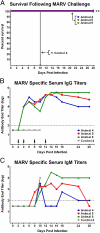Postexposure antibody prophylaxis protects nonhuman primates from filovirus disease
- PMID: 22411795
- PMCID: PMC3323977
- DOI: 10.1073/pnas.1200409109
Postexposure antibody prophylaxis protects nonhuman primates from filovirus disease
Abstract
Antibody therapies to prevent or limit filovirus infections have received modest interest in recent years, in part because of early negative experimental evidence. We have overcome the limitations of this approach, leveraging the use of antibody from nonhuman primates (NHPs) that survived challenge to filoviruses under controlled conditions. By using concentrated, polyclonal IgG antibody from these survivors, we treated filovirus-infected NHPs with multiple doses administered over the clinical phase of disease. In the first study, Marburg virus (MARV)-infected NHPs were treated 15 to 30 min postexposure with virus-specific IgG, with additional treatments on days 4 and 8 postexposure. The postexposure IgG treatment was completely protective, with no signs of disease or detectable viremia. MARV-specific IgM antibody responses were generated, and all macaques survived rechallenge with MARV, suggesting that they generated an immune response to virus replication. In the next set of studies, NHPs were infected with MARV or Ebola virus (EBOV), and treatments were delayed 48 h, with additional treatments on days 4 and 8 postexposure. The delayed treatments protected both MARV- and EBOV-challenged NHPs. In both studies, two of the three IgG-treated NHPs had no clinical signs of illness, with the third NHP developing mild and delayed signs of disease followed by full recovery. These studies clearly demonstrate that postexposure antibody treatments can protect NHPs and open avenues for filovirus therapies for human use using established Food and Drug Administration-approved polyclonal or monoclonal antibody technologies.
Conflict of interest statement
The authors declare no conflict of interest.
Figures





References
-
- Enria DA, Briggiler AM, Fernandez NJ, Levis SC, Maiztegui JI. Importance of dose of neutralising antibodies in treatment of Argentine haemorrhagic fever with immune plasma. Lancet. 1984;2:255–256. - PubMed
Publication types
MeSH terms
Substances
LinkOut - more resources
Full Text Sources
Other Literature Sources

